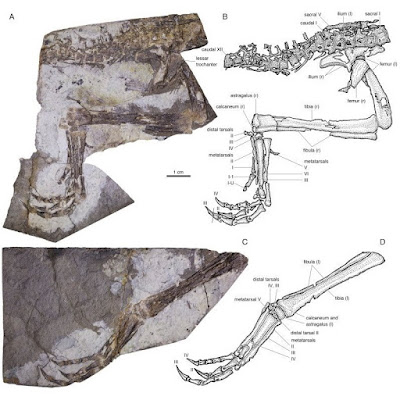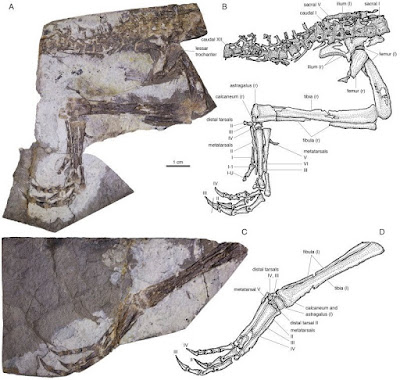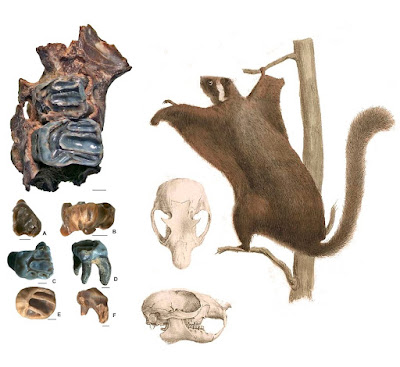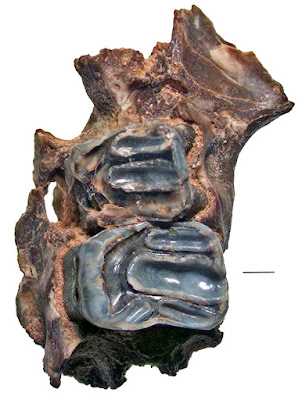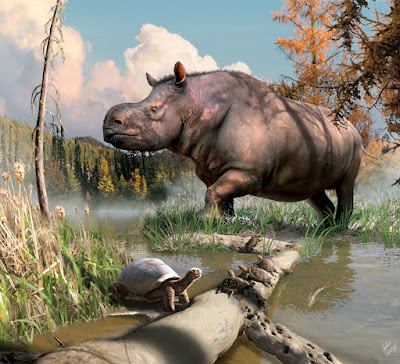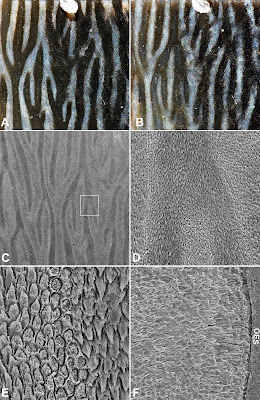[Most Recent Entries] [Calendar View]
Friday, November 1st, 2019
| Time | Event | ||||||
| 3:12a | [Paleontology • 2019] Xunmenglong yinliangis • A New Compsognathid Theropod Dinosaur from the Oldest Assemblage of the Jehol Biota in the Lower Cretaceous Huajiying Formation, northeastern China
Abstract Compsognathids — long regarded as an assemblage of ‘prototypical’ small theropods including the historically significant Compsognathus and Sinosauropteryx — have patchy distributions. The majority of definitive members of the clade come from the Upper Jurassic Solnhofen Archipelago and the Lower Cretaceous Yixian Formation. Chronologically falling between these two major compsognathid localities, a new compsognathid described in this paper, Xunmenglong yinliangis gen. et sp. nov., occurs in the Huajiyin Formation of northeastern China. Xunmenglong is distinguished from other compsognathids by one autapomorphy (pedal phalanx IV-4 longer than IV-3) and a unique combination of postcranial traits, including the disproportionately long lower legs. Nested among the Jehol and Solnhofen compsognathids in a phylogenetic analysis, Xunmenglong is an intriguing addition to the known range and diversity of the clade. The taxon is stratigraphically the lowest among Asian compsognathids, and its holotype specimen is the smallest among compsognathids (unless Scipionyx is treated as a compsognathid). Questions remain about habitat preferences and diversification patterns of compsognathids, but Xunmenglong offers two broader implications. (1) As previously proposed on the basis of the diverse enanthiornithine assemblage, the Huajiying Formation may preserve the oldest fauna of the Early Cretaceous Jehol Biota, which is distinct from the Late Jurassic Daohugou Biota and includes the Yixian Formation from which other Asian compsognathids were discovered. (2) Xunmenglong provides a useful calibration point with which to reconstruct biogeographic/stratigraphic patterns and to estimate allometric trends in the clade. Theropoda Marsh, 1881 Coelurosauria Huene, 1914 Compsognathidae Cope, 1871 Xunmenglong, gen. nov. Type and only known species. Xunmenglong yinliangis, sp. nov. Etymology. ‘Xunmeng,’ a Chinese Pinyin for being swift; ‘long’, Chinese Pinyin for dragon. Xunmenglong yinliangis, sp. nov. Etymology. ‘Yinliang’ after Yinliang Group, China. The Yinliang Stone Natural History Museum is operated by the philanthropic program of the founder (Liang Li), and is currently housed in the Global Stone Museum, Shuitou, Fujiang, China. Lida Xing, Tetsuto Miyashita, Donghao Wang, Kechung Niu and Philip J. Currie. 2019. A New Compsognathid Theropod Dinosaur from the Oldest Assemblage of the Jehol Biota in the Lower Cretaceous Huajiying Formation, northeastern China. Cretaceous Research. 104285, In Press. DOI: 10.1016/j.cretres.2019.104285 | ||||||
| 4:26a | [PaleoMammalogy • 2019] Petaurista tetyukhensis • The First Fossil Petaurista (Mammalia: Sciuridae) from the Russian Far East and Its Paleogeographic Significance
Abstract For the first time in the south of the Russian Far East in the Late Pleistocene cave deposits, fragments of the giant flying squirrel of the genus Petaurista were discovered. Petaurista tetyukhensis n. sp. is described based on a fragment of the upper jaw with two teeth and five isolated teeth from two cave locations. The main differences between the new species and living forms as well as other fossil species of the genus Petaurista are the absence of vertical groove on the lingual wall between the protocone and hypocone on M2, the absence of the anterior cross loph on the upper P4-M3, and the absence of mesoconids on lower, as a result of which the hypoflexid is not w-shaped. It is suggested that the Sikhote-Alin refugium allowed individual species to survive there during long unfavourable period of time and was the centre of speciation. Keywords: New species, Giant flying squirrels, Late Pleistocene, Refugium, Sikhote-Alin Systematic palaeontology Class Mammalia Linnaeus, 1758 Order Rodentia Bowdich, 1821 Family Sciuridae Hemprich, 1820 Subfamily Sciurinae Fischer de Waldheim, 1817 Tribe Pteromyini Brandt, 1855 Genus Petaurista Link, 1795
Petaurista tetyukhensis n. sp. Etymology: The species is named after type locality. The old name of Dalnegorsk Town (Tetyukhe) is used. Mikhail P. Tiunov and Dmitryi O. Gimranov. 2019. The First Fossil Petaurista (Mammalia: Sciuridae) from the Russian Far East and Its Paleogeographic Significance. Palaeoworld. In Press. DOI: 10.1016/j.palwor.2019.05.007 New species of a giant flying squirrel discovered in the Far East of Russia | ||||||
| 10:46a | [Paleontology • 2019] The First Tertiary Fossils of Mammals, Turtles, and Fish from Canada's Yukon
Abstract Despite over a century of prospecting and field research, fossil vertebrates are exceedingly rare in Paleogene and Neogene rocks in northern Canada's Yukon Territory. Here, we describe the first records of probable Neogene vertebrate fossils from the territory, including tooth fragments of a rhinocerotid, a partial calcaneum of an artiodactyl, shell fragments of the pond turtle Chrysemys s.l. and tortoise Hesperotestudo, and a fragment of a palatine of Esox (pike). Although the tooth fragments cannot be identified solely by traditional paleontological means, we use tooth enamel microstructure, and primarily the presence of vertical Hunter-Schreger bands, to refer them to the Rhinocerotidae. As the only known record of the Rhinocerotidae in North America's western Arctic, the tooth fragments from the Wolf Creek site support the hypothesis that the clade dispersed between Asia and North America across Beringia. The fossils are consistent with a Miocene age for the Wolf Creek site that is inferred from radiometric dates of the Miles Canyon basalt flows in the vicinity of the fossil locality. Further, the tortoise and pond turtle fossils indicate a mild climate in the Yukon at the time, consistent with the vegetation reconstructions of others that indicate a warmer, wetter world in the Miocene than today.
Jaelyn Eberle, J. Howard Hutchison, Kristen Kennedy, Wighart Von Koenigswald, Ross D.E. MacPhee and Grant Zazula. 2019. The First Tertiary Fossils of Mammals, Turtles, and Fish from Canada's Yukon. American Museum Novitates. (3943); 1-28. DOI: 10.1206/3943.1 Ancient rhinos roamed the Yukon phys.org/news/2019-10-ancient-rhinos-roa |
| << Previous Day |
2019/11/01 [Calendar] |
Next Day >> |
